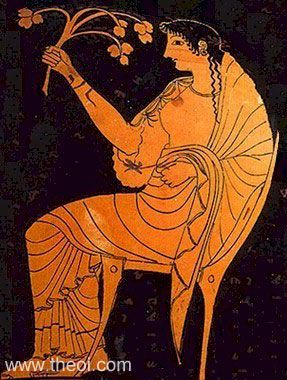
[34]
We have seen how the most amiable,
under physical stress,
become wolves, jackals,
mongrel curs;
we know further that hunger
may make hyenas of the best of us;
let us, therefore (though we do not forget
Love, the Creator,
her chariot and white doves),
entreat Hest,
Aset, Isis, the great enchantress,
in her attribute of Serqet,
the original great-mother,
who drove
harnessed scorpions
before her.
Once again we have a return to ancient Egypt in the form of the Jackal, Anubis. The jackal, a medium-sized carnivore with doglike features and a bushy tail, is widely distributed in Africa, the Middle East and India. This animal has long been the subject of superstition about death and evil spirits. The ancient Egyptians believed a jackal-headed god, Anubis, guided the dead to those who judged their souls. Such beliefs were probably encouraged by the jackal's cleverness, nocturnal habits, eerie howling and scavenging.

Anubis was charged with the measure of a person's life. When the dead reched the gates to the underworld, to the realm of Osiris, it was Anubis who would weight the heart against a feather on the scales of justive, thereby preserving the balance of good and eveil between the now and hereafter. If the person's life was just and good their heart was lighter than a feather and if it they lead a poor life then their heart would be heavier than the feather and it would be cast to Ammit, the eater of the dead.

The theme of the mongrel continues in the form of the Hyena. Hyenas have two niches in Africa. As real animals, filling the night wit their maniacal whoops and laughs, they hunt aggressively and are confident enough to terrorize lions. As creatures of myth, over the centuries they have generated fantastic tales of depravity and horror. Until modern times, reality and myth so commingled that the hyena ranked as the most misunderstood and most maligned animal in Africa.

The Hyena, in all of its misunderstanding, is still a wretched animal, but in its wretchedness gives Lions a run for their money. Lions, an essentially lazy animal in their social heirarchy, where the regal males laze around and assume first right to the kills generated by the femailes of a pride, stand as a symbol of power, at times the very image of soveriegnty and kingship. Could there be a double meaning in HD's use of Hyena here? As an animal that lives like a scavenger, the mongrel Hyena challenges the power, the best of us, when forced with untennable situations and plights, might like the Hyena take to fighting the established order and power, and we too might eat the dead in order to survive.
HD now switches gears to the subject of Doves: doves come from Cyprus, island sacred to Venus. Apuleis, but also others before him, tells us that Venus's chariot is drawn by snow-white doves, called in fact the birds of Venus because of their excessive lust. Others recall that the Greeks called the dove περιστερα, because envious Eros changed into a dove the nymph Peristera, much loved by Venus. Doves are the kissing bird, in nature, there is no season for love, love for the dove, or in actuality, the act of mounting the female, is a year round occupation for the male dove.

The dramatic shift from Jackals and symbols of the underworld to that of love as the creator is tempered by mentioning Hest. Hest could be short for Hestia and would keep with the Pan-Classical theme moving from the jackal to Hyena, perhaps also a parallel of Ammit. Hestia, the Greek Goddess of the hearth. She was also the link of the metropolis to the smaller outposts as the first thing that is necessary in establishing the home.

At this point HD takes a turn for the truly mystical, and also drawing a kind of parallel once more, a doubling, as all things in this seem to be doubled into their positive and negative forms, she invokes Isis but then invokes her as Serqet, the Scorpion Goddess of magic who protects against the venom of the scorpion and can kill with the same wrath. She is also the justified's rebirth mother, helping them be reborn in the afterlife.
 |  |
Serqet has two forms in art: as a scorpion with the head of a woman and as a woman with a scorpion on her head. She is also, in her ability to welcome the dead to the land of Osiris, a female counterpart to that of Anubis, in a way they are both Janus, the two headed Roman God of passages, but a male female split.
(I am) Serqet, mistress of heaven and lady of all the gods. I have come before you (Oh) King's Great Wife, Mistress of the Two Lands, Lady of Upper and Lower Egypt, Nefertari, Beloved of Mut, Justified Before Osiris Who Resides in Abtu (Abydos), and I have accorded you a place in the sacred land, so that you may appear gloriously in heaven like Ra.
-- Inscription in the Tomb of Nefetari, Serqet speaking to Nefertari

So in this section we are cautioned not to behave like scavengers and reminded that before monotheism dominated the land there was an older and more ecstatic cult that worshiped the great mother, the female godhead, which predates the male, and is both lustful and beautiful, violent and murderous, but equally as great as the male godhead of later monotheistic doctrines.




No comments:
Post a Comment